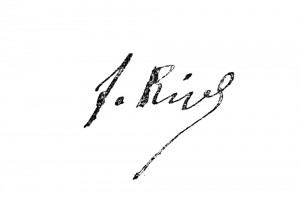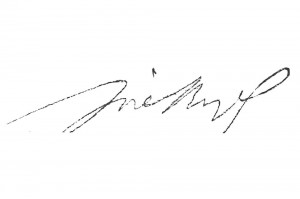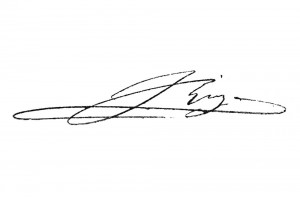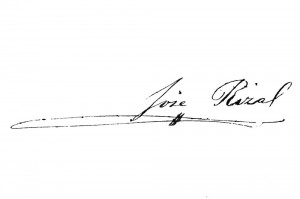 Architect and athlete Emmanuel Miñana is also a graphologist—a person who analyzes handwriting—and his abiding interest has been José Rizal’s scribblings on paper. He has studied specimens of Rizal’s signatures from ages 15, when the National Hero was a gifted student, to 36 years old, when he was about to become a martyr to the country’s struggle for freedom.
Architect and athlete Emmanuel Miñana is also a graphologist—a person who analyzes handwriting—and his abiding interest has been José Rizal’s scribblings on paper. He has studied specimens of Rizal’s signatures from ages 15, when the National Hero was a gifted student, to 36 years old, when he was about to become a martyr to the country’s struggle for freedom.
On October 8, Miñana will be giving a lecture on Rizal’s signatures at the Yuchengco Museum at RCBC Plaza.
Graphology is a way to understand a person’s psyche through his or her handwriting. The basic method consists of analyzing the size of the letters; the layout and direction of lines; the connection between letters and the first and second name; the rhythm, evenness, broadness, angle of letters, breadth of space, spacing between letters and the name; the pressure, frills and distortions and slope of the lines.
The formation of the letters indicates the nature of the person. If the letters tend to be circular, there is emotion. A squarish formation denotes logic. A triangular one connotes spirituality, and scribbles indicate creativity, says Miñana.
“The direction of the strokes say how expressive or repressed you are. The pressure shows how intense or mild you are. Depending on the slant, you are either reserved or outgoing.”
A graphologist can read a person’s character, the mood, the attitude toward himself or society. “You have a keen appreciation for lines, for shapes, the relationship of all these, and then you make a translation.”
“It’s normal for people’s signatures to change over time because the neurological impulses shift. Impressions in the mind are transmitted to the hand. All the facets that make up the person are imprinted in the signature. And so, your signature is your autobiography,” adds Miñana.
Personality traits
In Europe, employers favor analyzing applicants’ signatures over aptitude tests since they reveal the personality traits more than records do. Miñana does this when he’s hiring a family driver. Through the years, he’s helped friends before they’d entered into partnerships with prospective investors, and told couples about the true state of their marriage through their signatures. He even counseled a psychologist on her career plans.
 People can change their lives with a flick of the wrist or a change in stroke.
People can change their lives with a flick of the wrist or a change in stroke.
“You can change patterns if there are recurring negative tendencies. The handwriting needs to be adapted to the shift in the way you think about yourself. That’s the power of the mind. The signature is just a view from within. It shows you where you are but it always shifts.”
To take a closer look at Rizal, Miñana got signature specimens from the National Historical Institute’s compilation “One Hundred Letters of José Rizal to His Parents, Brother, Sisters and Relatives,” from the Lopez Museum. He also immersed himself at the Yuchengco library studying the correspondences between Rizal and his close friend, Ferdinand Blumentritt.
“I’m not a historian. I just have a fascination for people and, by the way, I read signatures. When I started to read the letters to Blumentritt, I would look at Rizal’s signature and see how he was feeling when he was writing that. As an intellectual, he would talk about everything under the sun, yet he would be cryptic about feelings. There would be a signature that would reveal that. After seven hours in the library, I was in tears,” he says.
Calligraphic
Through the years, changes in signature showed that Rizal had been through the wringer, as if something valuable had been taken from him. In the end, it was love for his country that carried him through.
Although Rizal wrote “Noli Me Tangere” and “El Filibusterismo” by hand, his writing was calligraphic. “He was in a zone, as if he was in a trance. When he signed his name, you could see where his mind and spirit were,” says Miñana.
When Rizal was in his teens, he exaggerated the tail of the letter “l” to emphasize his name, much like Felix Resurrecion Hidalgo and other Filipino intellectuals in Europe. “That was the style then. Like royalty, they underscored their signature as a form of distinction. Later on, that tail evinced itself to show his anger and frustration.”
The sharpness of the “J” at age 15 showed that Rizal was guided by spirituality and logic, and the big curlicue on the “R” revealed his affectionate ways with people. Miñana detected a pattern throughout Rizal’s life—how Rizal suppressed his emotions to put up with his image of being an intellectual. The formation of “R” also indicated family dynamics, such as his caring mother and a strict father.
When he was at the University of Sto. Tomas, certain letters projecting upwards showed how he tried to rise above the school’s conservative environment.
Miñana notes that till the last inkblot, Rizal experienced intellectual freedom in Europe, with the flying “S” and “L” pushing forward as he was poised to publish “Noli.” Then, certain downward strokes revealed his anger when his family and friends took the heat from the friars for his novel.
Different phases
 In 1895, the changes in signatures showed how Rizal went through different phases in his life—from the despondency of his exile and the excitement of meeting Josephine Bracken to the pain of losing a baby, then the betrayal of friends in Madrid and his family’s disapproval of his live-in relationship.
In 1895, the changes in signatures showed how Rizal went through different phases in his life—from the despondency of his exile and the excitement of meeting Josephine Bracken to the pain of losing a baby, then the betrayal of friends in Madrid and his family’s disapproval of his live-in relationship.
“When he wrote to his mother and sister, who was his confidante, Rizal was perfunctory. His mind was tenuous; it focused on the words. The composure was so controlled, you’ll see how calm he was. Then he let it all out in his signature.”
When Katipunan leader Pio Valenzuela approached Rizal about inspiring a revolution against Spain, the size of Rizal’s letters enlarged as if to show his zeal. However, the downstroke of the “l” came crashing down when Rizal was about to leave for Cuba. The direction foretold his fate.
Rizal’s letters to Bracken and his mother shortly before the execution also revealed his state of mind and how they summed up his relationship with them.
“When somebody writes ‘My Dear___,’ I can tell how dear that recipient is to the author,” says Miñana.
He admits that, “The study of Rizal has been trite. I never came up close to his humanity where I could feel his struggles, the lack of faith in himself, his fight with depression. It would  be lovely to share this with Filipinos so our memories are refreshed. Beyond historical accounts of a polyglot and an intellectual, my signature analysis of Rizal reveals a human being who gifted the country with his life.”
be lovely to share this with Filipinos so our memories are refreshed. Beyond historical accounts of a polyglot and an intellectual, my signature analysis of Rizal reveals a human being who gifted the country with his life.”
“The Signature of José Rizal: A View From Within,” October 8, 3 p.m., Master’s Gallery, Yuchengco Museum, RCBC Plaza, Ayala cor. Sen Gil Puyat Ave., Makati









































